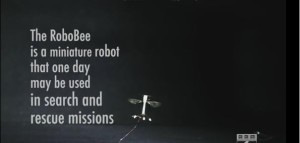Scientists at the Harvard Microrobotics Lab have developed a tiny robot – dubbed RoboBee – that can fly and stick to surface using static electricity.
Weighing just 0.08 grams, the RoboBee is equipped with a pair of tiny wings that can beat up to 120 times in one second. The first model of the tiny flying robot was unveiled by Harvard researchers in 2013, and that version featured a miniature tripod on its base for landings. However, the latest version has been provided with abilities to fix itself onto the underside of almost any material, including glass, leaves, wood, and brick.
Harvard roboticists say the RoboBee can perch during flight – much like birds, bats, or butterflies – to save energy.
“Many applications for small drones require them to stay in the air for extended periods,” said Moritz Graule, first author of the paper who conducted this research as a student at the Harvard John A. Paulson School of Engineering and Applied Sciences (SEAS) and Wyss Institute for Biologically Inspired Engineering at Harvard University.
“Unfortunately, smaller drones run out of energy quickly. We want to keep them aloft longer without requiring too much additional energy.”
“A lot of different animals use perching to conserve energy,” said Kevin Ma, a post-doc at SEAS and the Wyss Institute and coauthor.
“But the methods they use to perch, like sticky adhesives or latching with talons, are inappropriate for a paperclip-size microrobot, as they either require intricate systems with moving parts or high forces for detachment.”
The Harvard researchers used the concept of electrostatic adhesion to give Robobee abilities to perch during flight.
According to Graule, a small amount of energy is constantly supplied in the Robobee system to maintain the attraction between the robot and the surface. An electrode patch and a foam mount in this robot help absorb the shock. When a charge is supplied to electrode patch, the robot gets ability to stick to almost any surface. To detach the robot from the surface, the user just need to switch off the power supply.
Mirko Kovac, an aerial roboticist, suggests that Robobee developers should try to incorporate renewable energy sources (like solar panels) into their designs to give the robot abilities to recharge its batteries while taking five on branch.
“This incredibly important for inspection tasks,” says Kovac.
“Industrial inspection, for example, or environmental monitoring, like in the rainforest. Another one would be traffic control. There are many different applications, but it always comes back to the benefits of using much less energy.”
The detailed findings of the study have been published in journal Science. The paper was coauthored by Sawyer B. Fuller, Pakpong Chirarattananon, Noah Jafferis, Roy Kornbluh, and Matthew Spenko. The research was funded by the Wyss Institute for Biologically Inspired Engineering, the National Science Foundation, and the Swiss Study Foundation.
